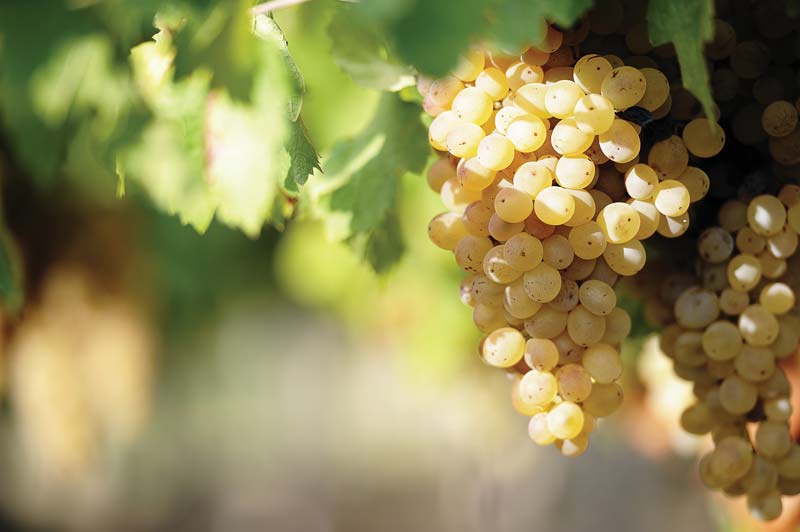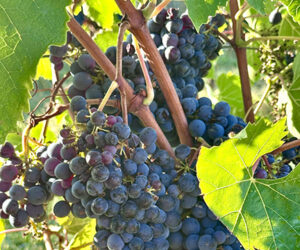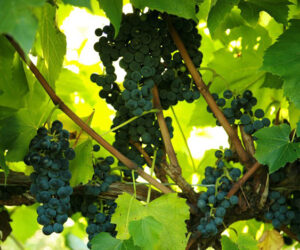A warm climate white wine grape
Writer’s block is something every writer experiences from time to time, and sometimes the blockade is removed under some of the most bizarre situations. We were shopping in the local Carrefour Express Market in Cullera, Spain, over the summer and I had a bottle of wine in each hand trying to decide which one to buy. I called over to my wife, Polly, and asked which one she “liked,” the one in my right hand or the left, without knowing either variety. Something was lost in the translation because she interpreted it as which one I should write about. Typical married couple of 33+ years, the Venus and Mars syndrome, I assumed she referred to the one in my right hand, which is the one that we purchased. We were walking back to our apartment and she asked me what made me decide on that variety. I responded it was the one in my right hand, just like she requested. Confusing looks on both of our faces told us we had no clue what had just happened, but in the end we enjoyed that bottle of Verdejo that evening over a good laugh! It was the “right” variety and as it turns out after all these years of writing this column, we have never covered it in detail.

Verdejo is named for the green color of its berries. It is truly an Old-World variety having been introduced to the Rueda region of Spain long before Moorish rule, around the 5th century. Verdejo is sometimes confused with the variety Godello, grown to the northwest in the Galicia region. Verdejo is also confused with the varieties Verdelho and Gouveio, which are both synonyms for Godello in nearby Portugal. However, DNA parentage analysis suggests Godello is a sibling of Verdejo.
The clusters are compact, small- to medium-sized, thin-skinned berries. They are early- to mid-budding, making it somewhat prone to spring frost. As the season progresses the berries take on a distinctive blue-green bloom, a coating on the berries themselves. Its vines are generally of low vigor and do best in warm to hot regions in low-fertility clay soils. It is highly susceptible to powdery mildew and tradition holds it is best cane pruned.
The Rueda is a warm climate region in the north central part of the country and Verdejo has been described as its pride and joy. It is Spain’s fifth most planted white wine variety with 44,333 acres (17,931 ha) reported in 2016, with an upward trend in vineyard area planted to it. It was mostly known for its fortified styles, but it has been a rising star in the dry whites it is being made into. Despite its popularity as a dry white varietal wine, the regulations of the Rueda DO allow for blending with another up and coming grape of the region, that being Sauvignon Blanc. The DO regulations do allow for white wines to be predominantly made from or solely from Sauvignon Blanc. A fairly progressive DO, you will also find Verdejo in sparkling wines and fortified Sherry-like wines.
The wines are very aromatic, medium to high acidity, and full bodied with notes of laurel and bitter almonds. They become nuttier with age and respond well to barrel fermentations and oak aging. Of course that all depends on how the fruit behaves in any given season and how the grapes and juice present themselves to the winemaker.
The wines are very aromatic, medium to high acidity, and full bodied with notes of laurel and bitter almonds.
There are two main contributing factors to making Verdejo wine in the style I prefer; yeast and acid. We’ll tackle the latter first. While I mentioned that the grape retains its acidity, that is relatively speaking. In warmer climates, some acid supplement may be necessary. The grapes generally come in at a pH around 3.8 and an acid of 0.55 g/L. The acidity and pH at harvest is very much influenced by soil type and rootstock. So for me, I always have an open mind when evaluating these parameters of the must. In my climate, other white grapes will come in with much higher pH values and lower acids, thus requiring a considerable acid supplement. With respect to Verdejo, a cursory glance tells us that the numbers are not bad and would probably be a nice wine if left alone. But I like a little crispness so I target to taste my whites with an acid level around 0.65 g/L and a general comfortability in driving the pH down a little bit. Therefore, I generally supplement with about a 1 g/L addition of tartaric acid at the crusher. I follow up after primary fermentation to make decisions on further acid supplement, if any is required. I tend to inhibit the malolactic fermentation (MLF) to preserve the acidity. I have toyed with MLF in the past on Verdejo grown in a vineyard block at UC-Davis, however I prefer the crisper version with grapes grown in California. That might be different in Virginia or Spain.
Now let’s consider the yeast. Hopefully you have read about some of the designer yeasts available because with respect to this variety, this can make a difference. I have done yeast trials with Verdejo and have found that the yeast QA23 (Lallemand) is the choice for me. Independent of the product literature, I found that this yeast fermented the most aromatic, clean, citrus-based flavors. I found that CY3079 (Lallemand) also produces wonderful aromatics, but I struggled at the end of the fermentation with some sulfide issues. That wasn’t the fault of the yeast; that was the winemaker. We all have our challenges. The take-home lesson on your yeast choice is to do your homework on them. They have to be happy to stay happy. It is your job as the winemaker to give them a reasonable juice to live in. Good sugar, good temperature control, and the equivalent of three square meals a day.
Over the years since I first worked with Verdejo I have done some practice on aromatic whites and how winemakers work to enhance those aromatics through some skin contact; with or without the use of enzymes. Personally, I tend to shy away from any enzymatic intervention in that while these products are well studied by the manufacturers and their technical support specialists are very willing to help out, it goes against my belief of “minimal intervention winemaking.” Verdejo is a delicate grape with thin skins so it should not require a lot of intervention. Rather than using the word “press,” I like to call it de-juicing the must, using rice hulls as a pressing aid to improve juice yields in a series of small, light cycles of the press. Squeeze until the juice flow slows down, back off, and massage it again. When I see the pH of this juice fraction climbing it implies your job is done! Elevations in pH during pressing tell me that I am fracturing the skins too much, releasing potassium. Remember that in dry white wines it is very easy to notice some of the phenolic components from the skins, so in my world it’s best to go easy.
Other winemaking considerations to ponder are the use of sur lie aging with bâttonage and the use of oak or oak products. It’s something to consider but it’s good to weigh your options having successfully moved on from the fruit processing and fermentation stage. Sur lie with bâttonage can help improve your mouthfeel, but also consider some enhancements of vanilla and butterscotch flavors with oak products, which can also lead to improved mouthfeel. Maybe a combination of the two. Whatever I decide to do, it is always keeping the preservation of the aromatics in mind. Low temperatures (less than 55 °F/13 °C) go a long way in preserving aromatics.
So whatever happened to the Spanish Carrefour Express shopping trip that was reminiscent of the comic strip characters Pickles and Earl (A couple that love each other dearly, but sometimes go about their daily lives in their own world, connecting most of the time, but periods of disconnection exist and become laughable at a later time)? Verdejo became our “go-to” white wine while we were visiting friends. We tried many styles — and it was fun. Our hosts, Jose and Edu, were not real big wine drinkers, but discovered something new and learned a lot about what is happening in the wine world nearby. They might as well have been living down the street from Disneyland having never visited their local Rueda wine country. For Polly and me, it was a great experience to focus on after a month in France. The vineyard block at UC-Davis where the Verdejo was grown is now gone. Succumbing to a changing staff, environment, disease, and growing priorities for something that matures somewhat later in the fall season when class starts. If I could ever get my hands on some of these delicious wine grapes without having to move to Spain, I’d be all over it.
Verdejo (Yield 5 gal./19 L)
Ingredients
100 lbs. Verdejo fruit or 6 gallons (23 L) juice
Distilled water
10% potassium metabisulfite (KMBS) solution (Weigh 10 g of KMBS, dissolve into about 75 mL of distilled water. When completely dissolved, make up to 100 mL total with distilled water.)
5 g Lalvin QA23 yeast
5 g Diammonium phosphate (DAP)
| g Fermaid K (or equivalent yeast nutrient)
Equipment
5-gallon (19-L) carboy
6-gallon (23-L) carboy
6-gallon (23-L) plastic bucket
Racking hoses
Inert gas (nitrogen, argon, or carbon dioxide will do)
Refrigerator (~45 °F/7 °C) to cold settle the juice (remove the shelves so that the bucket will fit)
Ability to maintain a fermentation temperature of 55 °F (13 °C)
Thermometer capable of measuring between 40–110 °F (4–45 °C) in one degree increments
Pipettes with the ability to add in increments of 1 mL
Tartaric acid (addition rate is based on acid testing results)
Step by Step
- If starting with juice, begin at step 7. Crush and press the grapes. Do not delay between crushing and pressing. Move the must directly to the press and press lightly to avoid extended contact with the skins and seeds.
- Transfer the juice to the 6-gallon (23-L) bucket. During the transfer, add 2.5 mL per gallon (0.66 mL per L) of 10% KMBS solution. (This addition is the equivalent of about 35 ppm SO2.
- Move the juice to a refrigerator at 45 °F (7 °C). Let the juice settle at least overnight. Layer the headspace with inert gas and keep covered.
- When sufficiently settled, rack the juice off of the solids into the 6-gallon (23-L) carboy.
- Mix up the Fermaid K in about 50 mL of previously boiled water (to sterilize it so you can add it to the juice) then add to juice.
- Prepare yeast. Heat the 50 mL water to 104 °F (40 °C). Do not exceed this temperature as you will kill the yeast. If you overshoot the temperature, start over, or add some cooler water to get the temperature just right. Sprinkle the yeast on the surface and gently mix so that no clumps exist. Let sit for 15 minutes undisturbed. Measure the temperature of the yeast suspension. Measure the temperature of the juice. You do not want to add the yeast to your cool juice if the temperature difference exceeds 15 °F (8 °C). Acclimate your yeast by taking about 10 mL of the cold juice and adding it to the yeast suspension. Wait 15 minutes and measure the temperature again. Do this until you are within the specified temperature range.
- When the yeast is ready, add it to the carboy and move the carboy to an area where the ambient temperature can be maintained at 55 °F (13 °C).
- You should see signs of fermentation within about two to three days. This will appear as some foaming on the surface and the airlock will have bubbles moving through it. If the fermentation has not started by day four, you might consider warming the juice to 60–65 °F (16–18 °C) temporarily to stimulate the yeast. Once the fermentation starts, move back to the lower temperature. If that does not work, consider re-pitching the yeast as described above.
- Dissolve the DAP in as little distilled water required to dissolve completely (usually ~20 mL). Add to the fermenting juice after the fermentation has started and is progressing noticeably.
- Normally you would monitor the progress of the fermentation by measuring Brix. One of the biggest problems with making white wine at home is maintaining a clean fermentation. Entering the carboy to measure the sugar is a prime way to infect the fermentation with undesirable microbes. So at this point, the presence of noticeable fermentation is good enough. Leave well enough alone for about two weeks.
- If your airlock becomes dirty by foaming over, remove it, clean it, and replace as quickly and cleanly as possible. Sanitize anything that will come in contact with the juice.
- Assuming the fermentation has progressed, then after about two weeks, it is time to start measuring the sugar. Sanitize your thief; remove just enough liquid to for your hydrometer. Record your results. If greater than 7 °Brix, then wait another week before measuring. If less than 7 °Brix, begin measuring every other day.
- Continue to measure the Brix every other day until you have two readings in a row that are negative and about the same.
- Taste the wine, if there is no perception of sweetness, consider it dry and add 3 mL of 10% KMBS per gallon (0.8 mL per L). If there are any sulfide like (rotten egg) odors, rack the wine off the lees. If the wine smells good, then let the lees settle for about two weeks and stir them up (bâttonage). Repeat this every two weeks for eight weeks. This will be a total of four stirs.
- After the second stir, check the SO2 and adjust to 30–35 ppm free.
- After eight weeks, let the lees settle. At this point, the wine is going to be crystal clear or a little cloudy. If the wine is crystal clear, then that is great! If the wine is cloudy, then presumably, (if you have kept up with the SO2 additions and adjustments, temperature control, kept a sanitary environment, and there are no visible signs of a re-fermentation) this is most likely a protein haze and you have two options: Do nothing – it’s just aesthetics or clarify with bentonite.
- While aging, test for SO2 and keep maintained at 30–35 ppm.
- Once the wine is cleared, it is time to move it to the bottle. This would be about six months after the onset of fermentation. Keep in mind this wine has had the malolactic fermentation inhibited. If all has gone well to this point, given the quantity made, it can probably be bottled without filtration. Your losses during filtration could be significant. That said, maintain sanitary conditions while bottling, and you should have a fine example of a clean, crisp Verdejo that pairs well with lemon-based chicken or seafood dishes. Enjoy with friends!







